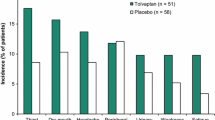Abstract
Tolvaptan, an oral, selective arginine vasopressin (AVP) V2 receptor antagonist has been approved for the treatment of euvolemic and hypervolemic hyponatremia in the United States. This report summarizes our center’s experience with thirteen patients treated for hyponatremia with one 15-mg dose of tolvaptan. The patients had euvolemic or hypervolemic hyponatremia with decreased serum osmolality and serum sodium (SNa) levels less than 129 mEq/L. Eight patients had a diagnosis of the syndrome of inappropriate antidiuretic hormone (SIADH), and five patients had a diagnosis of congestive heart failure (CHF). Results revealed an increase in SNa in all patients from 122.5 ± 4.2 to 128.9 ± 4.1 mEq/L (P < 0.05). The mean increase in SNa of 6.4 mEq/L (range 2–10 mEq/L) 24 h post-tolvaptan was not different in the two groups of patients, but SIADH patients had higher pre and post-tolvaptan SNa levels than CHF patients. Urine osmolalities (UOsm) decreased in all patients, and the patients with SIADH had significantly higher baseline UOsm and a larger decrease in UOsm 12 h post-tolvaptan administration when compared with the CHF patients. AVP levels did not change post-tolvaptan administration. However, the magnitude of increase in SNa levels was inversely related to pretolvaptan AVP levels in the SIADH subgroup (r = −0.7, P = 0.01). Three SIADH patients received small amounts of D5W to attenuate changes in SNa. No significant changes in mean arterial pressure, serum potassium, serum glucose, and blood urea nitrogen or serum creatinine were observed. The data show that tolvaptan is effective for the treatment of hyponatremia and may produce differing responses in disparate patient groups.


Similar content being viewed by others
References
Clayton JA, le Jeune IR, Hall IP (2006) Severe hyponatraemia in medical in-patients: aetiology, assessment and outcome. Q J Med 99:505–511
Hoorn EJ, Lindemans J, Zietse R (2006) Development of severe hyponatraemia in hospitalized patients: treatment-related risk factors and inadequate management. Nephrol Dial Transplant 21:70–76
Waikar SS, Mount DB, Curhan GC (2009) Mortality after hospitalization with mild, moderate, and severe hyponatremia. Am J Med 122:857–865
Wald R, Jaber BL, Price LL et al (2010) Impact of hospital-associated hyponatremia on selected outcomes. Arch Intern Med 170:294–302
Schrier RW (2006) Water and sodium retention in edematous disorders: role of vasopressin and aldosterone. Am J Med 119(7A):S47–S53
Miller M (2006) Hyponatremia and arginine vasopressin dysregulation: mechanisms, clinical consequences, and management. JAGS 54:345–353
Soupart A, Gross P, Legros J et al (2006) Successful long-term treatment of hyponatremia in syndrome of inappropriate antidiuretic hormone secretion with satavaptan (SR121463B), an orally active nonpeptide vasopressin V2-receptor antagonist. Clin J Am Soc Nephrol 1:1154–1160
Gheorghiade M, Gottlieb SS, Udelson JE et al (2006) Vasopressin V2 receptor blockade with Tolvaptan versus fluid restriction in the treatment of hyponatremia. Am J Cardiol 97:1064–1067
Metzger BL, DeVita MV, Michelis MF (2008) Observations regarding the use of the aquaretic agent conivaptan for treatment of hyponatremia. Int Urol Nephrol 40:725–730
Verbalis JG (2006) Whole-body volume regulation and escape from antidiuresis. Am J Med 119(7A):S21–S29
Sieste R, van der Lubbe N, Hoorn EJ (2009) Current and future treatment options in SIADH. Nephrol dial Transplant 3(suppl):iii12–iii19
Udelson JE, Smith WB, Hendrix GH et al (2001) Acute hemodynamic effects of conivaptan, a dual V1a and V2 vasopressin receptor antagonist, in patients with advanced heart failure. Circulation 104:2417–2423
Velez JC, Dopson SJ, Sanders DS et al (2010) Intravenous conivaptan for the treatment of hyponatraemia caused by the syndrome of inappropriate secretion of antidiuretic hormone in hospitalized patients: a single-centre experience. Nephrol Dial Transplant 25:1524–1531
Schrier RW, Gross P, Gheorghiade M et al (2006) Tolvaptan, a selective oral vasopressin V2-receptor antagonist, for hyponatremia. N Engl J Med 355(20):2099–2112
Renneboog B, Musch W, Vandemergel X et al. (2006) Mild chronic hyponatremia is associated with falls, unsteadiness, and attention deficits. Am J Med 119:71.el–71.e8
Sajadieh A, Binici Z, Mouridsen MR et al (2009) Mild hyponatremia carries a poor prognosis in community subjects. Am J Med 122:679–686
Sandhu HS, Gilles E, DeVita MV et al (2009) Hyponatremia associated with large-bone fracture in elderly patients. Int Urol Nephrol 41:733–737
Hoorn EJ, van der Lubbe N, Zietse R (2009) SIADH and hyponatraemia: why does it matter? Nephrol Dial Transplant 3(suppl):iii5–iii11
Mohmand HK, Issa D, Ahmad Z et al (2007) Hypertonic saline for hyponatremia: risk of inadvertent overcorrection. Clin J Am Nephrol 2:1110–1117
Sterns RH, Hix JK (2009) Overcorrection of hyponatremia is a medical emergency. Kidney Int 76:587–589
Gheorghiade M, Konstam MA, Burnett JC Jr et al (2007) Short-term clinical effects of tolvaptan, an oral vasopressin antagonist, in patients hospitalized for heart failure. JAMA 297:1332–1343
Otsuka America Pharmaceutical, Inc. (2009) SAMSCA (tolvaptan) tablets product monograph, Otsuka Pharmaceutical Co., Ltd., Tokyo, pp 1–6
Acknowledgments
The authors are grateful to Ms. Mia Aguayo for her expert assistance in regard to the preparation of this manuscript.
Author information
Authors and Affiliations
Corresponding author
Rights and permissions
About this article
Cite this article
Vaghasiya, R.P., DeVita, M.V. & Michelis, M.F. Serum and urine responses to the aquaretic agent tolvaptan in hospitalized hyponatremic patients. Int Urol Nephrol 44, 865–871 (2012). https://doi.org/10.1007/s11255-011-9996-8
Received:
Accepted:
Published:
Issue Date:
DOI: https://doi.org/10.1007/s11255-011-9996-8




